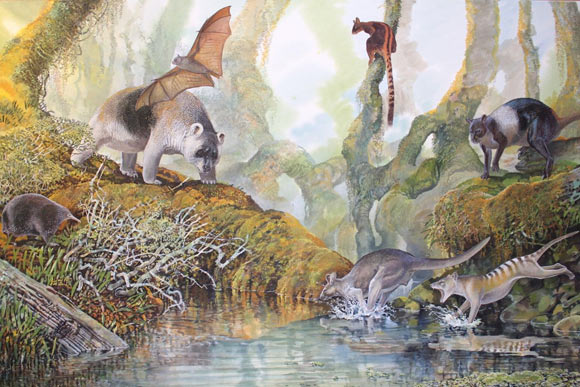The kangaroo is one of Australia's signature creatures. It is seen on flags, the coat of arms, official military symbols, airlines, sports teams, films, you name it. Evereything Australian!
But even though it is so well tied to the country and its culture, kangaroos are not just found in Australia.
A few species are found to the north of Australia, on the island of New Guinea. In particular, these are smaller species, such as certain tree-kangaroos and wallabies. These roos are unique to New Guinea, having evolved there separately over many thousands of years.
And now paleontologists are finding that there are unique extinct species of that once lived in New Guinea, too. And they are anything but small!
Recently, a new study of a kangaroo fossil revealed it to be of a giant species that had no relationship to any modern kangaroos in Australia. It is called Nombe nombe. And if you love roos like we do, its story will make you hop with joy!
Discovering Nombe nombe
Red kangaroos are the world's largest roo species. Nombe nombe was probably a similar size, but it was not closely related. (Getty Embed)
The fossil that we know Nombe nombe from is a jawbone that is about 50,000 years old. It was similar size to today's red kangaroo, which are the largest living roos. This is about 2 metres (6.6 feet tall).
Unlike those modern kangaroos, it had a squater, more muscular body, and a shorter muzzle, or nose and jaw. To the best of scientists' understanding, they had much in common with tree-kangaroos that live in New Guinea today. Only so much larger!
Interestingly, the jawbone was first found in 1970 at a dig site called the Nombe Rockshelter. It was thought to be a part of the prehistoric Protemnodon genus—these were the ancestors of Aussie kangaroos. It wasn't until a new study (led by two professors named Isaac Kerr and Gavin Prideaux) that science understood that this fossil didn't belong to Protemnodon at all. It was a species all its own!
Check out the jawbone in the video below.
A fossil lower jaw of Nombe nombe from I. A. R. Kerr on Vimeo.
Land bridge journeys
You might rightly wonder how animals as unique as kangaroos ended up on just these two island nations. Why there and not on other islands in the area?
The answer is that until around five million years ago, New Guinea and Australia were connected by what is known as a land bridge. No, this isn't something that anyone built! Around this time, seas levels were much lower. This meant that land in between the two islands were exposed. Animals could travel freely between the two places. And this included the prehistoric relatives of kangaroos!
In those days, many of the roos were megafauna, meaning giant animals. Megafauna were found all over the world, including giant sloths, bears, elks, and more. Nombe nombe was one of these very large roos.
Separate evolutions
Tree-kangaroos are common in New Guinea and some species are found only there. They have squat bodies and shorter ears and muzzles. (Getty Embed)
Eventually though, the sea levels rose, and that land bridge was covered by water, becoming the Torres Strait. Now separated from each other, the kangaroos on each island evolved differently.
On Australia, many of the kangaroo species stayed quite large, a good fit when living and travelling across the country's huge open spaces. In fact, Australia is still home to a few strikingly large creatures of all types, including reptiles like saltwater crocodiles and birds like emus.
But New Guinea features mountains and tightly packed rainforests. It is full of dense, tough vegetation. As most animals around the world became smaller, so did the island's marsupials. Today, their kangaroos species are dog-sized wallabies, as well as tree-kangaroos that spend most of their lives above the ground.
But if you could travel far enough back, a good 40,000 or 50,000 years, you would've found the massive Nombe nombe. Its strong jaws and teeth were perfectly adapted to feeding in its rainforest home.
Did it hop? How long did it live? So far, we don't know. This extinct creature is only known from a pair of incomplete fossils. But hopefully further digging elsewhere in New Guinea will reveal the secrets of this amazing ancient marsupial.
 A painting of many prehistoric species from New Guinea. The Nombe nombe is seen top right. (Peter Shouten)
A painting of many prehistoric species from New Guinea. The Nombe nombe is seen top right. (Peter Shouten)









